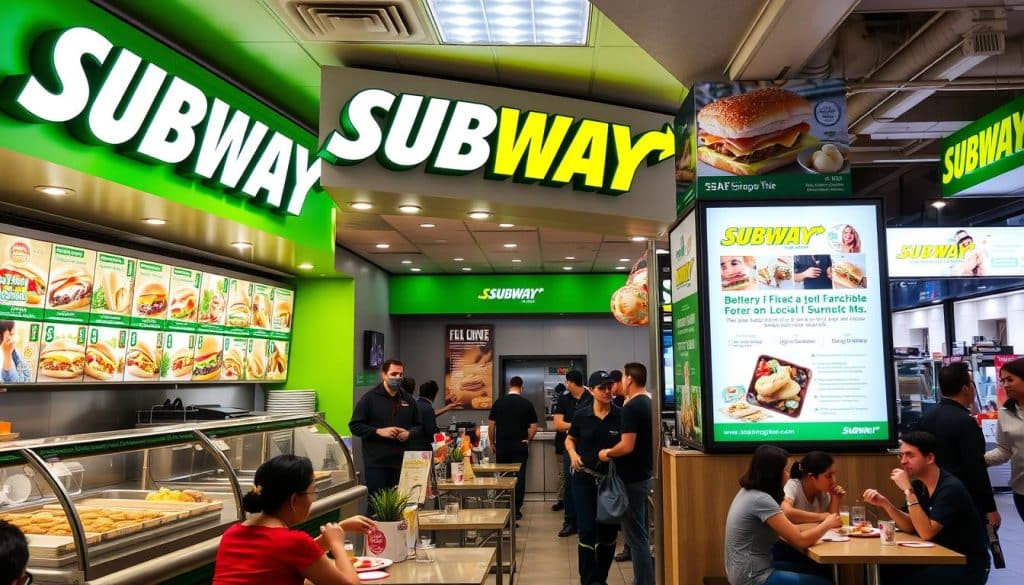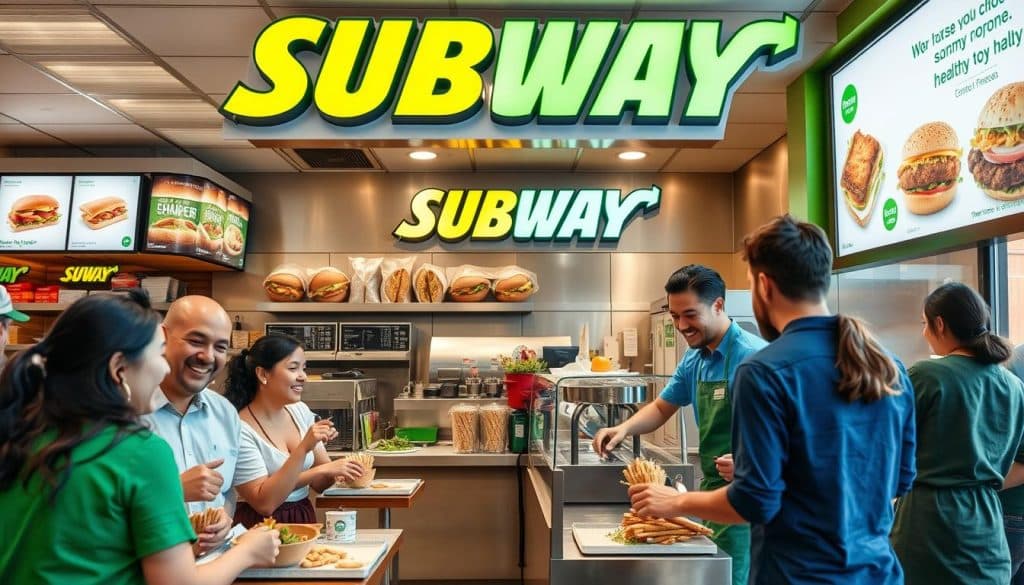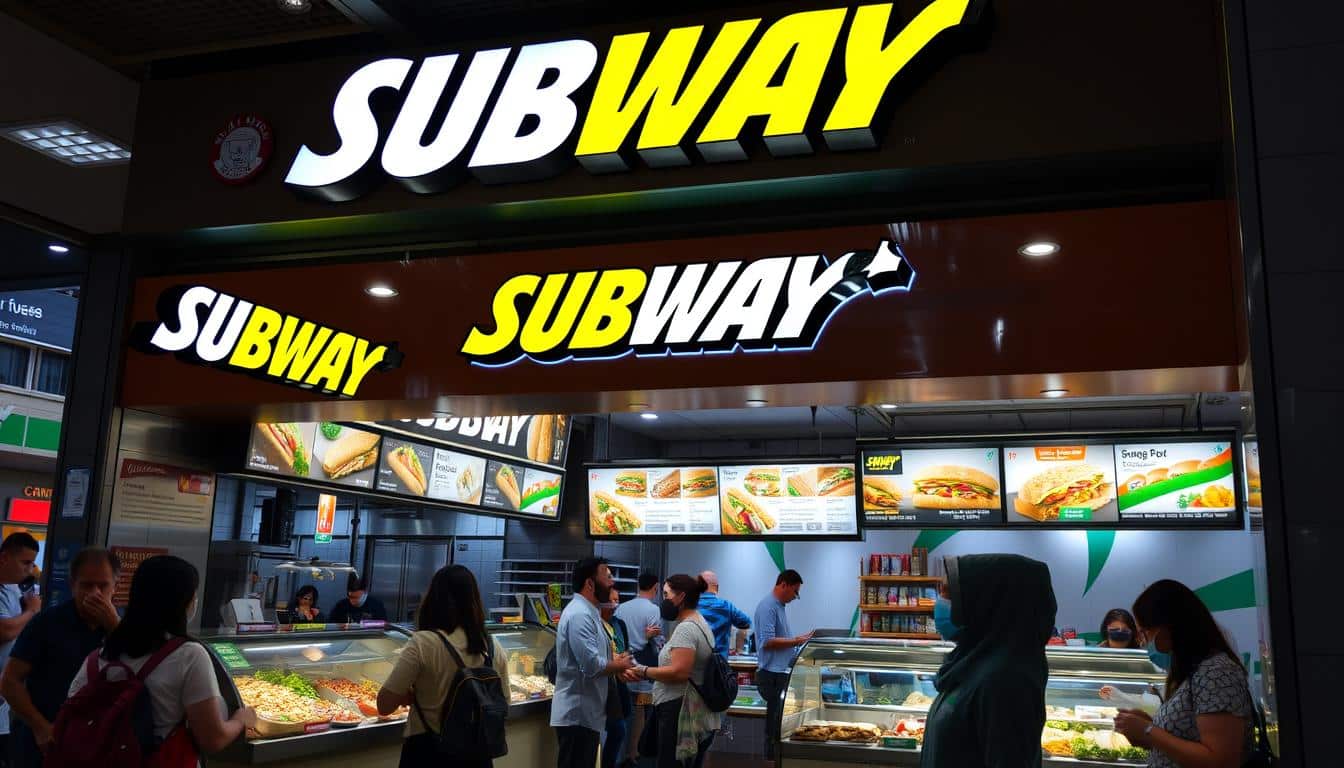Ever thought about investing in a Subway franchise? Could it lead to financial freedom, or is it just a risk in a crowded market?
Subway is a big name in quick-service restaurants, with over 37,000 locations worldwide. It’s known for healthy sandwiches and a customizable menu. But, starting a Subway franchise comes with costs and challenges. You’ll need to consider the investment, like a $15,000 franchise fee, and ongoing fees.
Understanding the fast-food franchising world is key. It helps you see if Subway is a good choice. The idea of making money is tempting, but is it realistic? Check out this guide for more on costs.
Key Takeaways
- The total investment range to start a Subway franchise in the US is between $244,050 and $537,300.
- Subway franchisees need to maintain a minimum net worth of $150,000 and $100,000 in liquid assets.
- The average annual revenue for Subway franchisees is around $400,000, with profit margins between 15-22%.
- Subway’s combined royalty and marketing fees total 12.5% of gross sales.
- Subway has experienced 10 consecutive quarters of positive growth, reflecting its resilience in the fast-food market.
Overview of Subway Franchise Model
The Subway franchise model is a top choice for entrepreneurs wanting to get into fast food. It started with a focus on fresh ingredients and letting customers customize their meals. Knowing Subway’s history helps us see why it’s so successful today.
History of Subway
Subway was founded in 1965 as a small sandwich shop. It has grown into a global brand, leading the quick-service restaurant industry. Its journey shows Subway’s ability to adapt and focus on quality, making it a top sandwich chain.
Throughout its growth, Subway has always listened to customers and worked to be efficient. This has helped it expand.
Business Structure
The Subway franchise model is great for new business owners because it requires a low initial investment. It offers a streamlined supply chain and a standard menu. This makes it easier for franchisees to start and grow their businesses.
Subway also allows franchisees to open in places like gas stations and college campuses. This helps them reach more customers. Plus, Subway’s size lets it get better deals on supplies, saving franchisees money and boosting profits.
Key Success Factors
Several things make Subway franchises successful. Strong brand recognition and a focus on customer choice are key. Subway also adapts its menu to fit local tastes, like vegetarian options in India and halal choices in the Middle East.
Franchisees who use these strategies well can do very well financially. This makes Subway a great choice for those looking to start a business.
Initial Investment Requirements
Starting a Subway franchise requires understanding the financial side. The initial fee is between $15,000 and $25,000, based on location. It’s key for those looking to invest to plan their finances well.
Franchise Fees
The initial fee is just a part of the cost to start a Subway franchise. It gives you the right to use the Subway name and access to support and training. You’ll also pay 8% of your sales in royalties and 4.5% for national marketing. Knowing these costs is important for anyone thinking about investing in a Subway franchise.
Real Estate Costs
Real estate costs are a big part of the investment. Leasing or building a location can cost between $100,000 and over $250,000. This depends on the location and type of property. Renovations can add another $75,000, making the total investment higher based on the market.
Equipment and Inventory
Equipment and inventory costs add to the financial burden. You’ll need to spend around $30,000 on kitchen gear. Plus, an initial stock of food and supplies costs about $15,000. Prospective franchisees need to account for these expenses to understand the financial commitment.
Training and Support for Franchisees
Running a Subway franchise needs good training for subway franchisees and ongoing help. Subway has a detailed plan to help owners face business challenges. Knowing the subway franchise requirements is key for new owners starting out.
Initial Training Program
New owners go through a two-week training at Subway’s headquarters. This program covers important topics like running the store, food prep, and managing stock. It gives them the skills to manage their restaurants well.
This training is the first step to meeting subway franchise support standards. It lays a strong base for their business.
Ongoing Support and Resources
After the initial training, owners get access to many resources for success. They get help from business consultants on marketing, running the store, and supply chain. The University of Subway also offers training and certification programs.
This support helps new owners, even if they have no restaurant experience. It makes it easier for them to start their business.
Marketing and Advertising
Marketing and advertising are key to Subway’s success. Subway’s strong brand draws a loyal customer base. This loyal group knows Subway’s wide range of options.
This knowledge helps franchisees. They can use Subway’s big campaigns and also focus on local markets. This mix is powerful for growth.
Brand Recognition
Subway is well-known, thanks to a big social media presence. It has 22 million Facebook fans and 2.2 million Twitter followers. This online presence boosts Subway’s visibility.
Subway works with influencers too. For example, it teamed up with 42 influencers to promote new Signature Wraps. This effort reached many people and got lots of engagement.
Local Marketing Strategies
Franchisees should use local marketing that speaks to their community. The “Subway MyWay Rewards” program helps. It rewards customers for their purchases, keeping them coming back.
Local events and promotions also help. They make Subway stand out in a crowded market. This way, Subway stays competitive against big names like McDonald’s and Burger King.

Operational Guidelines and Standards
Subway franchise operations depend on strong operational guidelines and standards. Following these rules helps franchisees run their businesses efficiently. They also make sure their work matches Subway’s high quality standards.
Comprehensive training and ongoing support are key. They help franchisees keep up with these standards. This lets them focus on giving customers a great experience.
Daily Operations
Managing a Subway franchise involves many tasks. These include keeping track of inventory, scheduling staff, and following food safety rules. A structured approach to these tasks makes the workflow smooth.
Franchisees get the tools and resources they need. This helps them serve fresh, high-quality food to customers.
Quality Control Measures
Subway focuses a lot on quality control. These measures ensure ingredients stay fresh and the dining experience is top-notch. Franchisees must regularly check and follow set protocols to meet these standards.
Keeping high standards is linked to customer happiness. In the fast-food world, this is very important.
Financial Performance and Earnings
Understanding a Subway franchise’s financial performance is key for those interested in owning one. On average, a Subway location makes about $490,000 a year. This is a 4.3% jump from the year before. The location and how well it’s run greatly affect sales.
Franchise owners can make anywhere from $40,000 to over $150,000 a year. This depends on how well they manage the business.
The success of a Subway franchise depends a lot on keeping costs low. A good franchise can make around 20% profit, sometimes up to 25%. But, there are costs like 8% royalty fees and 4.5% for ads to consider.
To do well, a franchise needs careful management and smart marketing. This is how you boost your financial success.
Challenges Facing Subway Franchisees
The fast-food industry is always changing, bringing big challenges for Subway franchise owners. Brands like Chick-fil-A and Jersey Mike’s are competing hard for customers. This competition makes it tough for Subway owners to keep sales up and stay in business.
Competition in the Fast Food Sector
Franchisees have seen a big drop in sales, down by 16% from last year. This is part of a bigger trend in fast food, where everyone is trying to attract health-focused customers. Subway tried to boost sales with the $6.99 footlong deal, but it might not be enough against the competition.
Changing Consumer Preferences
Customers are now looking for healthier and greener food choices. Subway owners need to quickly add new menu items to keep up. But, introducing these new items can be expensive, costing between $50,000 and $100,000 for store updates. They also have to work long hours, up to 91 hours a week, which can be very challenging.
Also, Subway switched from Coca-Cola to Pepsi, causing worries for franchisees. Many are hesitant to sign the new drink contract because of unclear terms. The fear of losing their franchise if they don’t comply adds to the stress Subway owners face.
Benefits of Owning a Subway Franchise
Owning a Subway franchise comes with many perks for entrepreneurs. People are attracted to the unique benefits it offers. One big plus is the chance to manage your business while following Subway’s rules.
This setup lets you make choices that fit your local market. You can adjust your operations to do better.
Flexibility and Ownership
Subway franchises offer more than just money. They give you control over your business and how you serve customers. You can set your hours and staff levels, giving you freedom.
This personal touch helps you meet your community’s needs. It can make your customers happier and more loyal. Plus, it helps you build strong ties in your area.
Established Brand and Customer Base
Subway’s well-known brand is a big plus. With over 37,000 locations worldwide, you get instant recognition. This reputation helps attract loyal customers.
Subway also offers national marketing and sales ideas. For example, the “$5 Footlongs” promotion was a hit during tough times. This means more chances for growth that new businesses don’t have.

Steps to Become a Subway Franchisee
Starting your journey to become a Subway franchisee requires a detailed application process. You must fill out a Subway franchise application. This includes financial documents and background information. Subway uses this to check if you’re a good fit, based on your financial status.
Application Process
After applying, you’ll start looking for the perfect location. This is a key part of becoming a franchisee. You’ll work with Subway’s real estate team to find a spot that fits their standards and market plans.
Site Selection and Development
The whole process is about making smart choices and planning ahead. By understanding the application and site selection, you can help Subway grow. With over 20,133 units in the U.S., you’ll join a successful brand. You’ll get support and resources to help you succeed.





